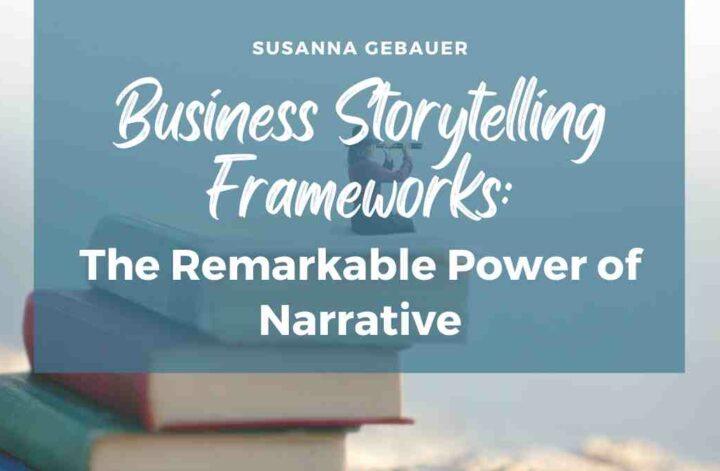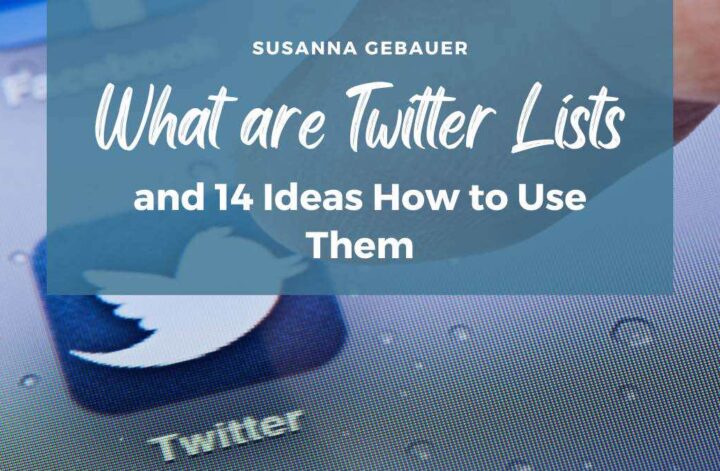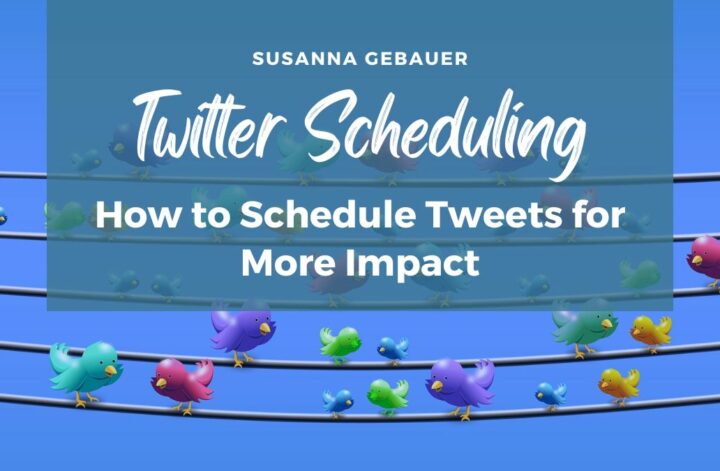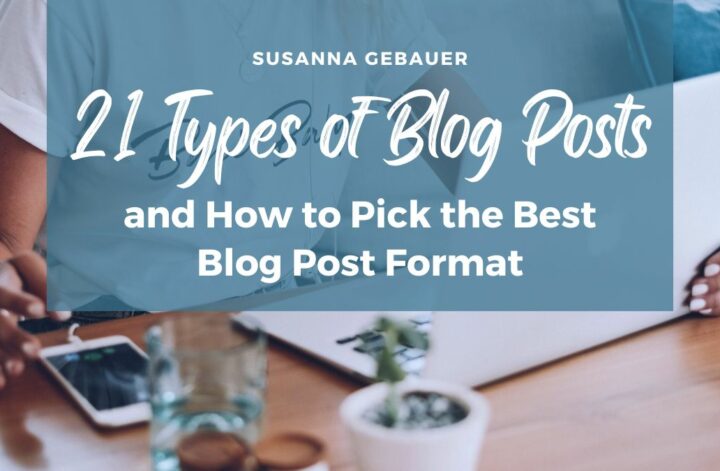Stories can build an emotional connection with your audience. Emotions drive engagement and conversions. However, not every story is captivating. Business storytelling frameworks help you craft stories that lure your audience into your narrative, capture and hold their attention, and bring them to the story climax that triggers actions.
Business storytelling frameworks make sure that you use the full power of a consistent storyline to build tension, trigger the right emotions, and guide the audience toward a desired outcome.
Learn how business storytelling frameworks can help you craft stories like a pro and discover the most used business storytelling frameworks. If you pay attention you will recognize some of them from emails you received and landing pages you visited.
What is Business storytelling?
Have you ever felt that many online entrepreneurs are telling the same story in their sales copy? Something along this line: “I faced this problem that you also have, I tried all solutions and tips but nothing worked for me, then I found this one simple hack and suddenly it all became a breeze, and now I am a successful billionaire traveling the world and having fun. And I have created this magic product that lets you find success in no time.”
That is because this is the most common storytelling framework used in business content marketing: The Hero’s Journey.
Other storytelling frameworks also work well to build a brand and business. Although stories and storytelling are known to build community and speak to your audience on an emotional level, not every story captures attention and triggers emotions.
Knowing about the most important story frameworks can tremendously help to build tension and invoke the emotions that have the power to make you money.
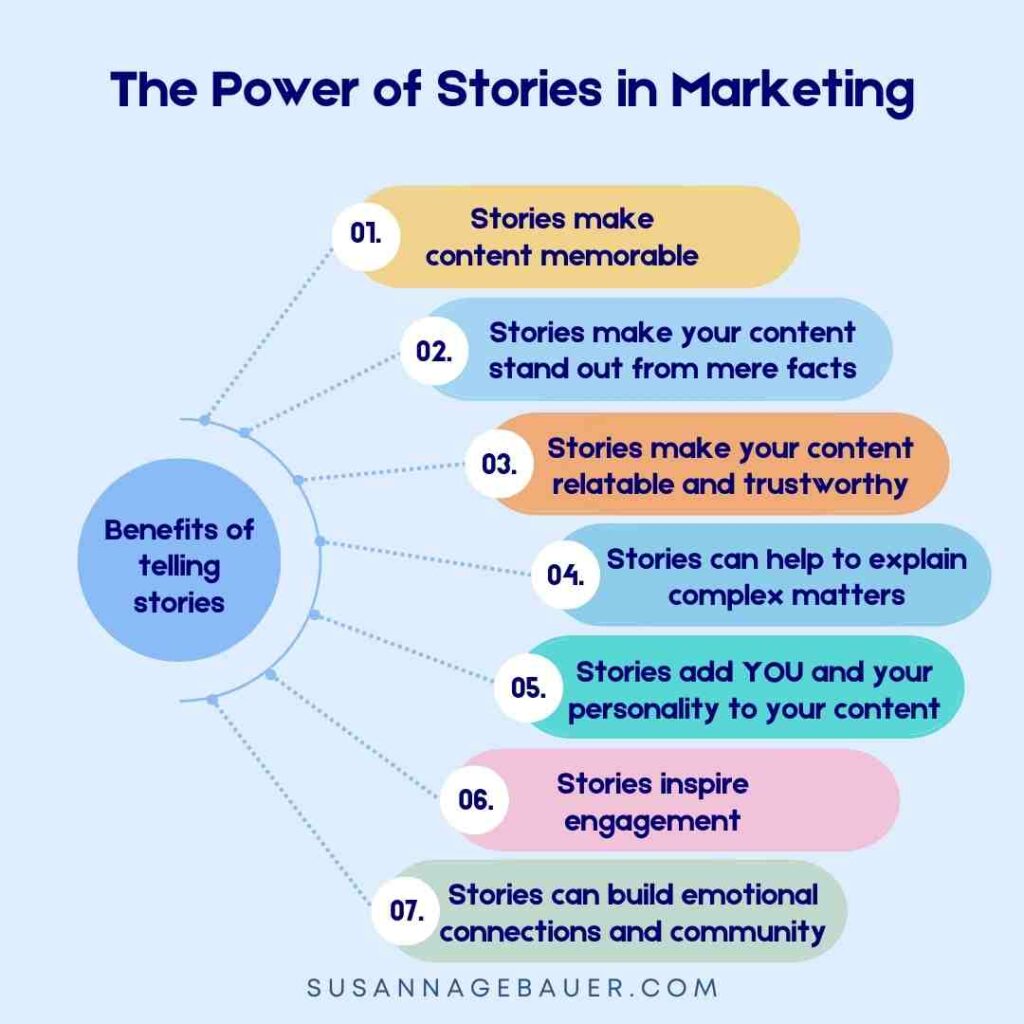
Business storytelling purposefully uses stories to achieve business goals and specific outcomes. These stories are carefully crafted to make the audience take action. They use emotions and mental triggers.
Importance of Storytelling in Business
Stories have tremendous power when used strategically.
Telling stories in your marketing content has some important benefits:
- Stories make content memorable
- Stories make your content stand out from mere facts
- Stories make your content relatable and trustworthy
- Stories add YOU and your personality to your content
- Stories inspire engagement
- Stories can help to explain complex matters
- Stories can build emotional connections and community
The Psychological Impact of Stories
We can explain the emotional effect of a great story as a chemical process with dopamine and cortisol. But the impact of storytelling is a lot more complex.
Processing facts activates two areas of the brain, stories activate additional areas. Logic undoubtedly lets us search for facts for proof, our brain looks for stories instead to make sense of complex matters and trust the narrative.
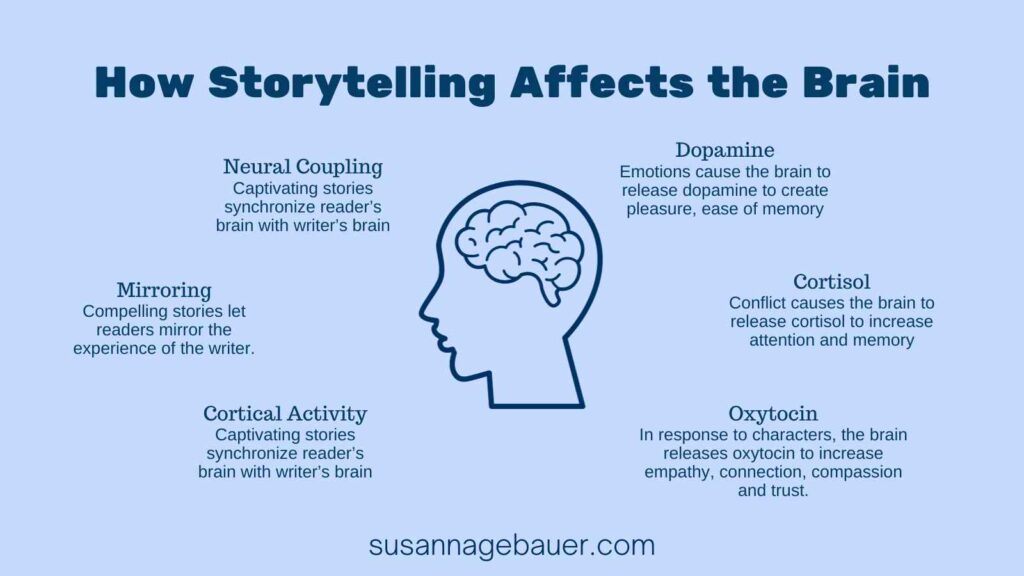
Stories synchronize the audience and storyteller. If you want your audience to think in a specific way, your story can achieve that by relating experiences that are similar to the ones of your audience. Readers can identify with the storyteller or protagonist.
Stories inspire emotions. Emotionally charged triggers cause the brain to release dopamine which creates a pleasurable response and makes it easier to remember the story.
conflict boosts attention and memory. That is why conflict is often part of the business storytelling frameworks.
Stories can make us feel passion, sadness, hardships and joy, meaning and purpose. Effective stories can take us through complete emotional journeys. Have you ever read a story and cried or felt anger? Then you know what I mean.
Good stories help to structure content and guide the reader through complex matters.
Stories play with the images they paint in our brains. These images make stories memorable.
Stories have the power to influence our way of thinking. You can ultimately use this to make your audience take the desired action.
Why Business Storytelling Frameworks Matter
It took me a while to discover the power of storytelling.
As a mathematician, I tend to cut down content until mere facts remain. But content focused on facts is often not the best or most efficient content.
Not everyone is a born storyteller. Even with the knowledge about the power of storytelling, it may be hard to turn topics into stories – or even discover stories worth telling.
You have to learn not to stray too far from the purpose of your content and stick to a line of thoughts and arguments that will take the reader on a journey with your story.
You have to find the balance between the emotional side of your story and the information it contains.
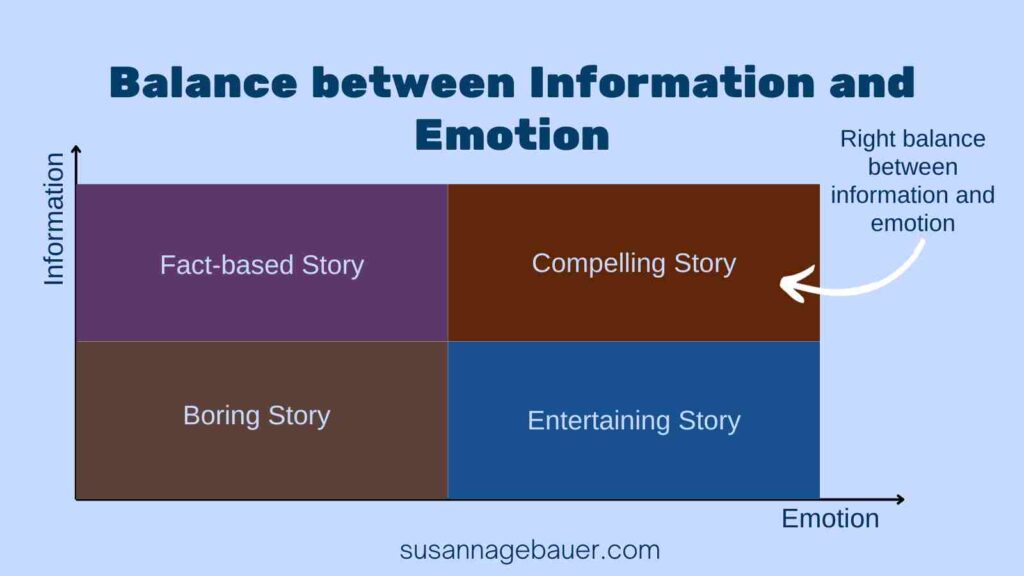
That is when storytelling frameworks come into the game.
If you want to start using storytelling in your online content, storytelling frameworks can tremendously help craft a consistent storyline for the purpose at hand.
Storytelling frameworks do just that: they provide you with a framework for your story. A framework that guides you through the necessary stages to tell an exciting story that triggers emotions, builds tension, and plays with the psychological impact of content.
You can choose from various frameworks for different situations and purposes.
Once you have read about the most common business storytelling frameworks, you will be able to recognize them in newsletters, blog posts, and sales letters – even on some product landing pages.
Common Business Storytelling Frameworks
#1 The Hero’s Journey
The Hero’s Journey is a widely used framework that is also referred to as the monomyth. It describes the common structure of stories across cultures and time periods. It is a universal pattern that can be found in myths, legends, fairy tales, novels, films, and even business stories. follows a straightforward outline:
The Hero’s Journey is a twelve-stage process that guides the protagonist from their ordinary life to their ultimate transformation. The stages are as follows:
Departure
1. The Ordinary World: Introduces the protagonist (aka hero) and their everyday life. Establishes the protagonist’s desires and goals.
2. The Call to Adventure: The protagonist is presented with an opportunity or challenge that disrupts their ordinary life. The call to adventure marks the beginning of the hero’s journey.
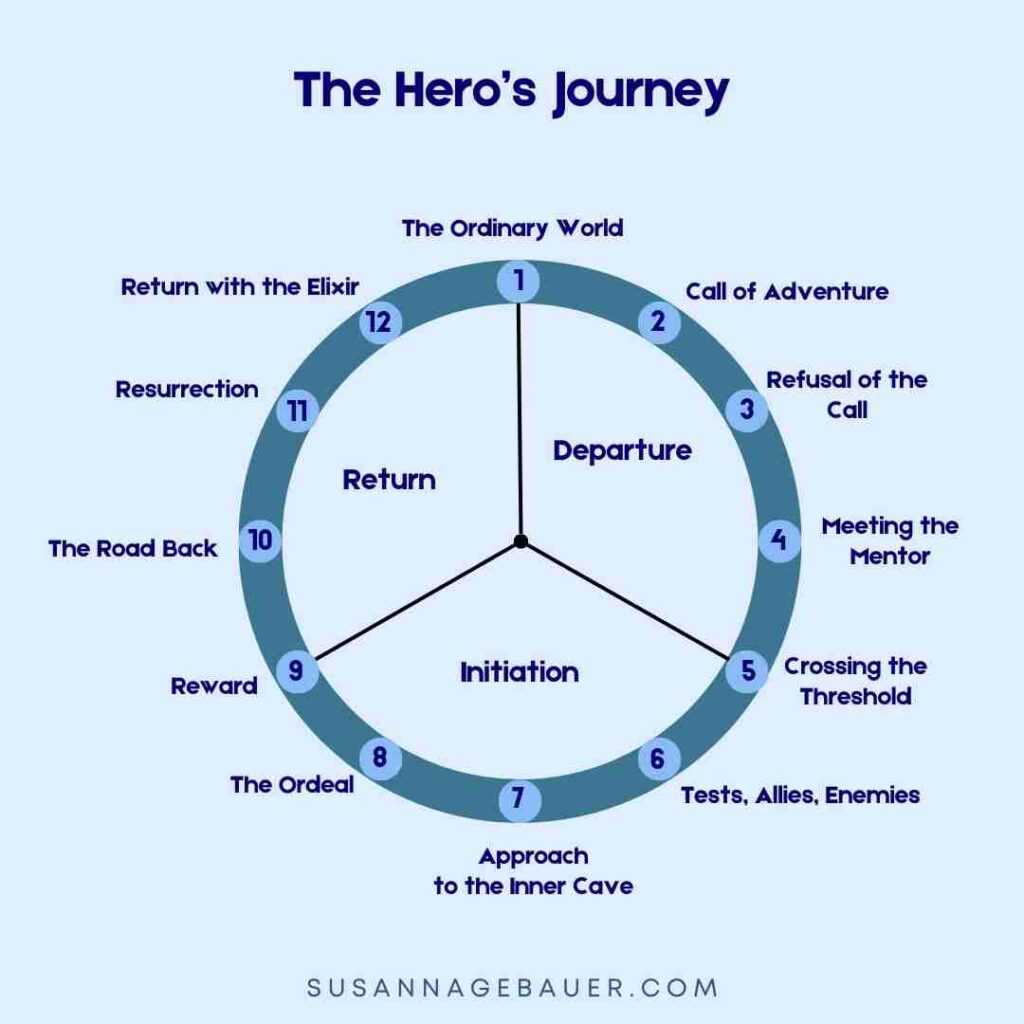
3. Refusal of the Call: The protagonist initially resists or hesitates to accept the call to adventure. They may fear the challenges or responsibilities that lie ahead.
4. Meeting the Mentor: The protagonist encounters a wise and experienced mentor who provides guidance, support, and encouragement. The mentor helps the protagonist prepare for the challenges they will face on their journey.
Initiation
5. Crossing the Threshold: The hero takes the first step into the unknown, embarking on the treacherous path of their journey. They leave behind their ordinary life and enter a world of adventure and transformation.
6. Tests, Allies, and Enemies: The hero faces a series of obstacles and challenges, they encounter allies who help them and enemies who hinder their progress. They learn new skills, develop their courage, and grow as a person.
7. Approach to the Inner Cave: The hero approaches the central challenge or confrontation that lies at the heart of their quest. They face their deepest fears, weaknesses, and vulnerabilities.
8. Ordeal: The hero faces the ultimate test, facing their deepest fears and vulnerabilities. They may lose everything they hold dear and face their mortality.
Return
9. Reward: The hero acquires a treasure, knowledge, or power that will aid them in completing their quest. This could be physical, symbolic, or spiritual in nature.
10. The Road Back: The hero begins their journey back home, bearing the fruits of their adventure. They face new challenges and temptations as they seek to return to their world.
11. Resurrection: The hero faces a final challenge or temptation that threatens to derail their return. They must overcome their doubts and reaffirm their commitment to their purpose.
12. The Return with the Elixir: The hero is transformed and victorious, overcoming their limitations and achieving their true potential. They share their newfound wisdom and experiences with the world, inspiring others to embark on their own journeys of self-discovery.
The Hero’s Journey is a powerful tool for storytelling because it taps into our shared human experiences of transformation, growth, and overcoming challenges. It is a universal language that you can use to connect with audiences on a deep emotional level.
It is often used in sales messages where the “elixir” becomes the new super product. The hero now puts everything he experiences and learns into a product that will make it so much easier for all buyers to achieve the same results without all the struggles.
#2 The Three-Act Structure
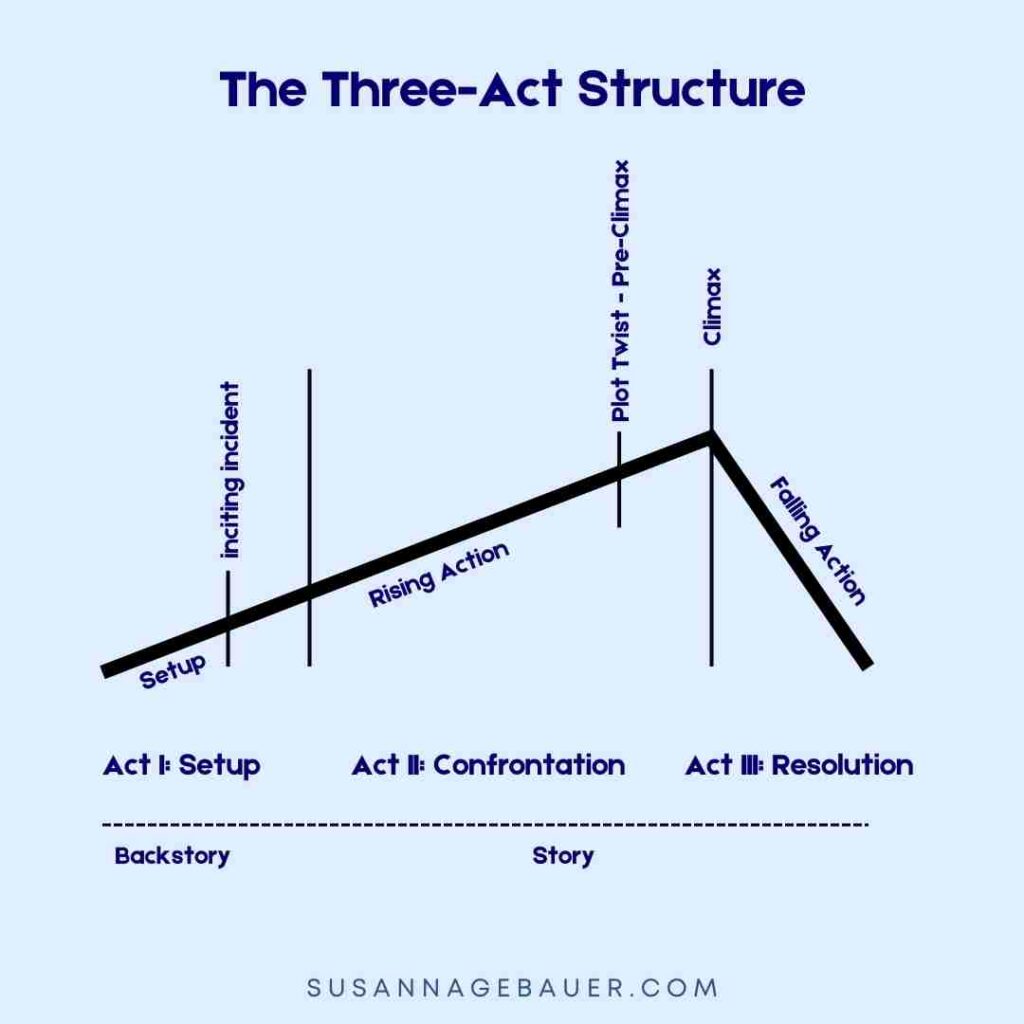
The Three-Act Structure is a storytelling framework that divides the narrative into three distinctive elements:
- Setup
- Confrontation
- Resolution
The Setup introduces the setting, the characters and their relationships. An inciting incident disrupts the protagonist’s ordinary life and propels them into the main conflict. The conflict or the problem clearly defines the protagonist’s challenge or goal. In a business context, this is the challenge or problem the main character (often that is you or one of your clients whose story you are telling) of the story is facing and the kind of solution they are looking for.
The Confrontation is the heart of the story, where the protagonist faces escalating challenges and obstacles, leading to their transformation. It’s a period of rising action, with the protagonist’s growth and determination being tested. The protagonist is presented with new challenges and obstacles they have to overcome. In a business context, this often describes all the solution attempts and failures. With every failure and struggle the tension (and desperation) rises.
The Resolution brings the story to a close:
- Pre-Climax: A rising tension and sense of urgency as the protagonist approaches the climax.
- Climax: The culmination of the story’s conflict, where the protagonist must make a critical decision or take decisive action. This is often a give up or try one more time situation. The idea for a new tactic or solution attempt is presented.
- Resolution: The conflict is resolved, and the protagonist achieves their goal or faces the consequences of their choices. This usually is the discovery of the one big solution that they have been looking for all the time but never found. But now, finally, they have the secret key to solve the problem.
- Denouement: The aftermath of the climax, where loose ends are tied up and the story’s themes are explored. Proof for the concept should be presented: Numbers to showcase the success, and case studies of clients who have already tried the solution.
#3 The Freytag’s Pyramid
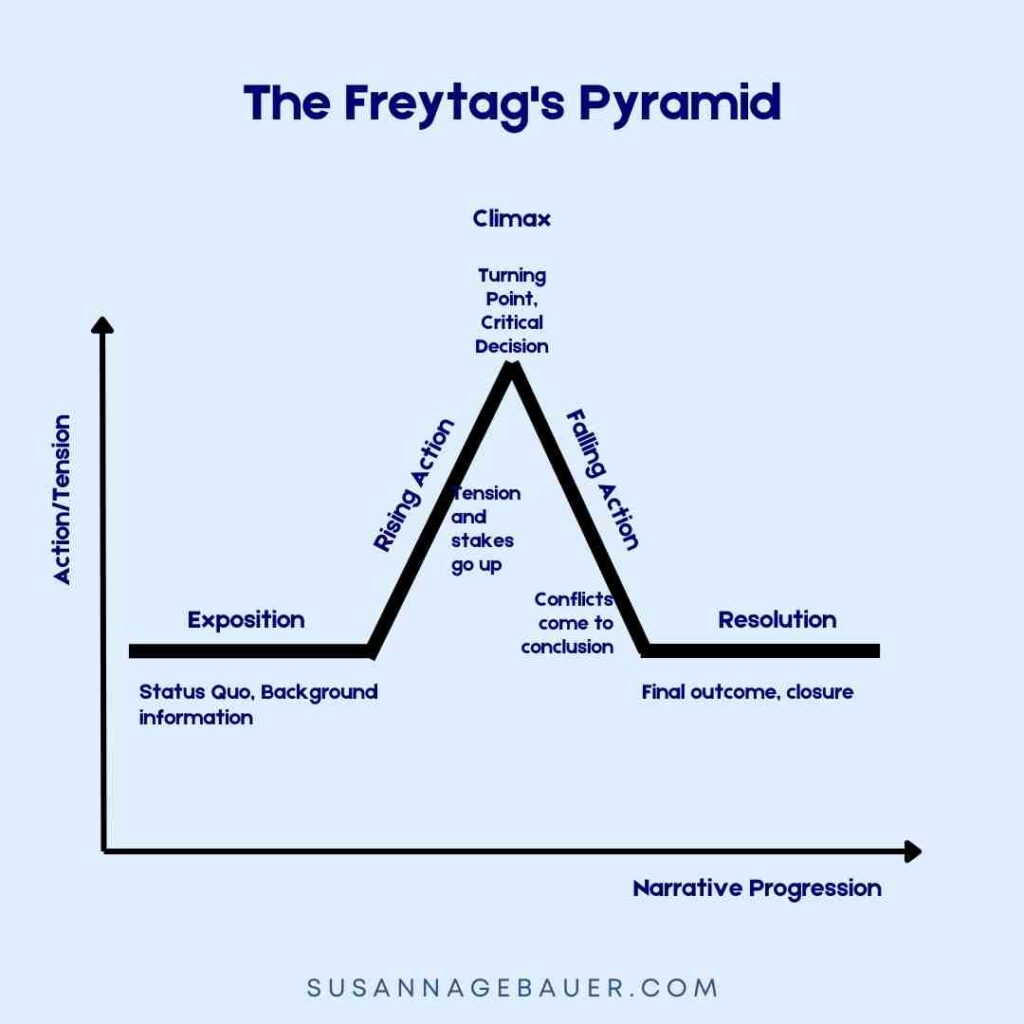
Freytag’s Pyramid is a dramatic structure commonly used in literature and storytelling to map out the rise and fall of tension within a narrative. It was introduced by German novelist and playwright Gustav Freytag in his book “Die Technik des Dramas” (The Technique of the Drama) in 1863.
The pyramid consists of five narrative sections:
- Exposition: This is the introduction to the characters, setting, and the basic situation. It provides the necessary background information to understand the story.
- Rising Action: In this phase, the central conflict or problem begins to develop. Events and complications arise, building the tension and leading towards the story’s climax.
- Climax: The climax is the turning point of the story. It is the moment of greatest tension, where the conflict reaches its peak. The main character faces a critical decision or confrontation that will determine the outcome of the story.
- Falling Action: After the climax, the story begins to wind down. Loose ends are tied up, and the intensity of the conflict diminishes. The consequences of the climax start to unfold.
- Resolution(Denouement): This is the final outcome of the story. Any remaining questions are answered, and the characters’ fates are revealed. The resolution provides closure to the narrative.
#4 The StoryBrand framework
The StoryBrand framework is a marketing and communication strategy developed by Donald Miller, outlined in his book “Building a StoryBrand: Clarify Your Message So Customers Will Listen.” This framework is designed to help businesses and individuals create a clear and compelling message that resonates with their audience. The central idea is to position the customer as the hero of the story, with the business or brand serving as a guide to help the hero (the customer) overcome challenges and achieve success.
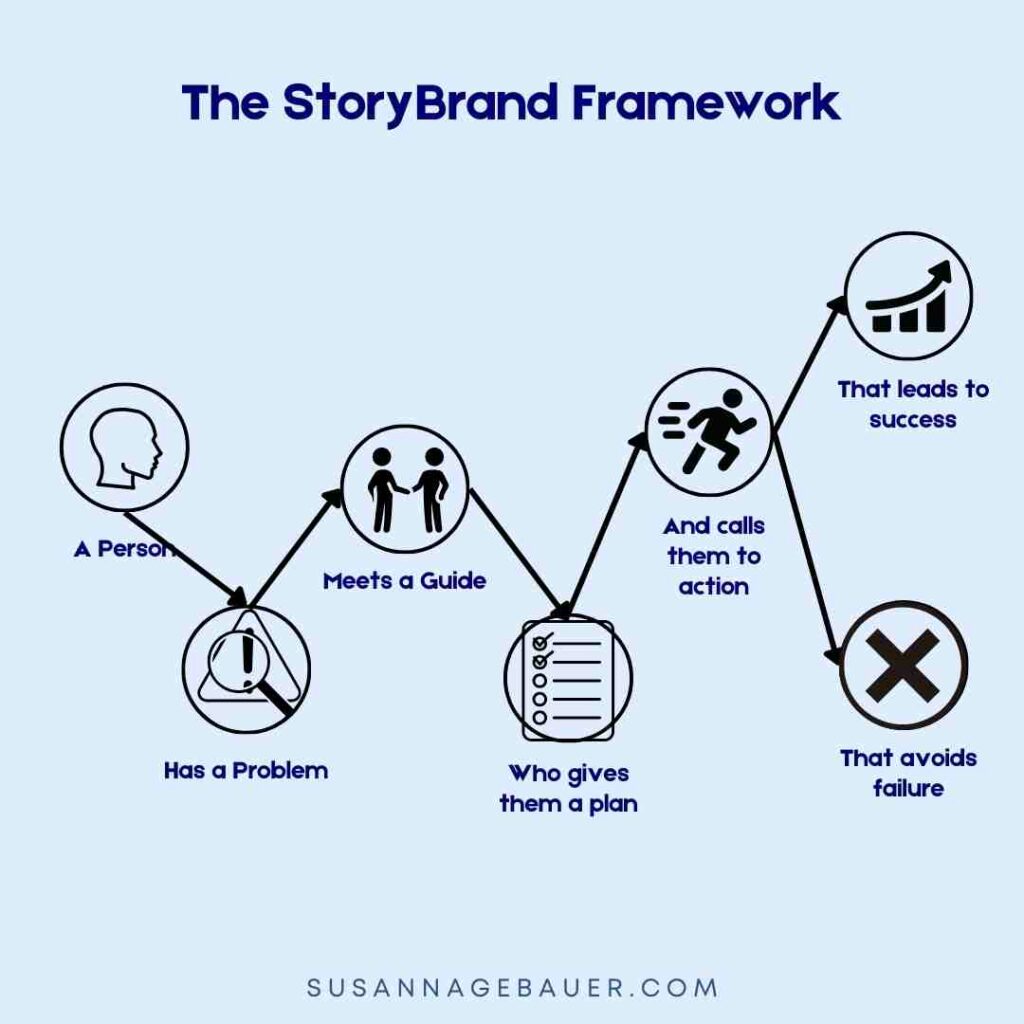
Here are the key components of the StoryBrand framework:
- Character(Hero): In the StoryBrand framework, the customer is the hero. The business or brand is positioned as the guide, not the hero. This shift in perspective helps create a customer-centric message.
- Problem: Identifying the problem also sets the stage for the solution provided by the business or brand.
- Guide(Mentor): Position the business or brand as the guide or mentor who can help the hero (customer) overcome the challenges.
- Plan: Clearly outline a plan or solution that the business offers to address the customer’s problem. Provide a roadmap for the customer to follow.
- Call to Action: Communicate the next steps or actions that the customer should take.
- Success(Transformation): Paint a picture of what success looks like for the customer after using the product or service.
- Failure(Cost of Inaction): Highlight the negative consequences of not taking action.
The StoryBrand framework is widely used in marketing and brand messaging to create a narrative that resonates with customers, clarifies the value proposition, and ultimately drives engagement and conversions. It’s especially popular for its simplicity and focus on creating a customer-centric story.
#5 The Pixar Story Framework
The Pixar Story Framework, also known as the Pixar Pitch, is a storytelling structure attributed to the creative minds at Pixar Animation Studios. While not as formalized as some other storytelling frameworks, it’s often discussed as a loose guide to creating compelling and emotionally resonant narratives. This framework is not only used in the creation of Pixar’s animated films but has also become popular as a general storytelling guideline. The key elements of the Pixar Story Framework include:
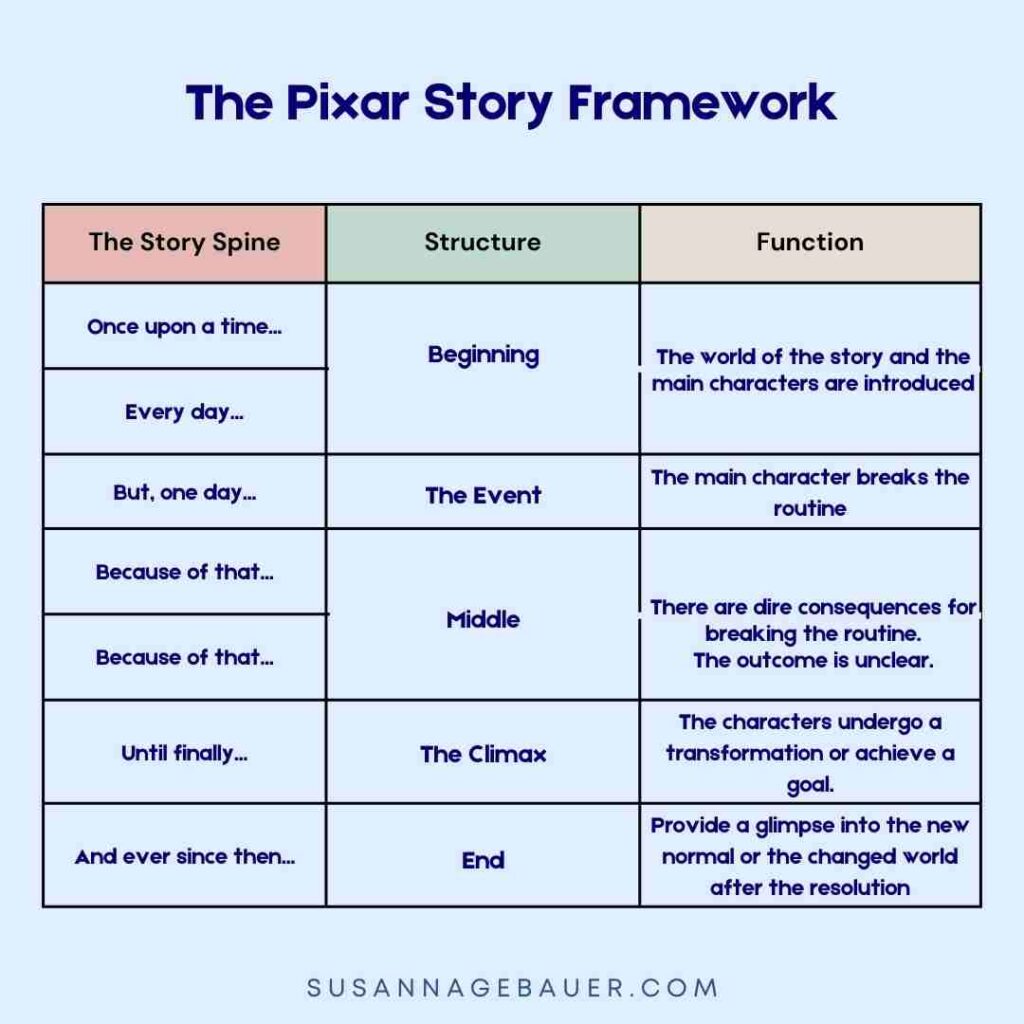
- Once upon a time…: This sets the stage for the story by introducing the main characters, the setting, and the initial situation.
- Every day…: Describes the normal life of the characters before the central conflict or inciting incident occurs.
- One day…: This is the inciting incident, the event that disrupts the normal routine and sets the main plot in motion. It introduces the main conflict or challenge that the characters must face.
- Because of that…: Describes the series of events or consequences that unfold as a direct result of the inciting incident. Each action leads to a reaction, and the story develops in response to the initial challenge.
- Because of that…: This is a continuation of the cause-and-effect chain. The characters respond to challenges and conflicts, with each new action leading to further consequences.
- Until finally…: This is the climax or resolution of the story. It represents the culmination of the character’s journey and the resolution of the central conflict. The characters undergo a transformation or achieve a goal.
- And ever since then…: This provides a glimpse into the new normal or the changed world after the resolution of the conflict. It shows the lasting impact of the characters’ journey.
The Pixar Story Framework is a simple yet effective way to outline the key components of a narrative. It emphasizes the importance of character development, cause and effect, and the transformational journey. While it may not be as rigid as some other storytelling frameworks, it offers a flexible guide for crafting engaging and emotionally resonant stories.
Most classic fairy tales that I have been told in my childhood follow more or less the Pixar Story Framework. As a business storytelling framework, I would use it for a social media post, blog article or an email – not so much for a sales page.
#6 The Problem-Agitate-Solve(PAS) framework
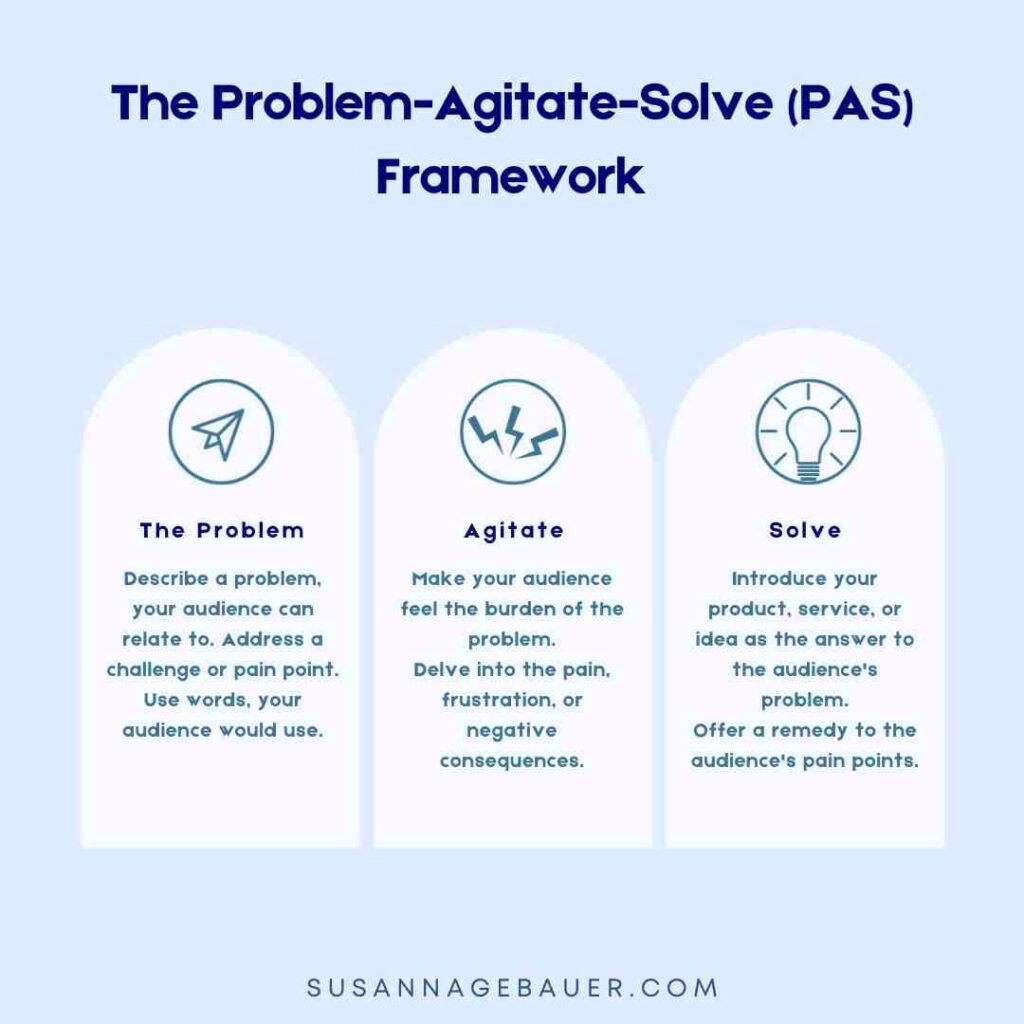
The Problem-Agitate-Solve (PAS) framework is a copywriting and marketing approach used to structure persuasive messages and content. It is designed to engage and persuade an audience by addressing a problem, agitating that problem to emphasize its impact, and then presenting a solution. The PAS framework is often employed in sales pages, advertisements, social media hooks and other marketing materials.
Here’s a breakdown of each component:
- Problem: Begin by identifying and stating the problem that your target audience is facing. The goal is to resonate with the reader or viewer by addressing a challenge or pain point that they can relate to. The more accurately and empathetically the problem is articulated, the more likely the audience will be to continue reading or listening.
- Agitate: After presenting the problem, agitate it by delving deeper into the pain, frustration, or negative consequences associated with it. The idea is to make the problem feel more acute and pressing, intensifying the emotional impact on the audience. This step aims to create a sense of urgency and a heightened desire for a solution.
- Solve: Once the problem has been clearly stated and agitated, present the solution. This is where you introduce your product, service, or idea as the answer to the audience’s problem. Communicate how your solution addresses the challenges highlighted earlier and provides relief or improvement. The emphasis here is on positioning your offering as the remedy to the audience’s pain points.
The PAS framework is effective because it taps into the psychology of problem-solving and emotional engagement. By addressing a problem the audience cares about, making it feel more pressing, and then presenting a solution, marketers aim to guide the audience towards a desired action, such as making a purchase or taking a specific next step.
#7 The Context, Action, Results (CAR) framework
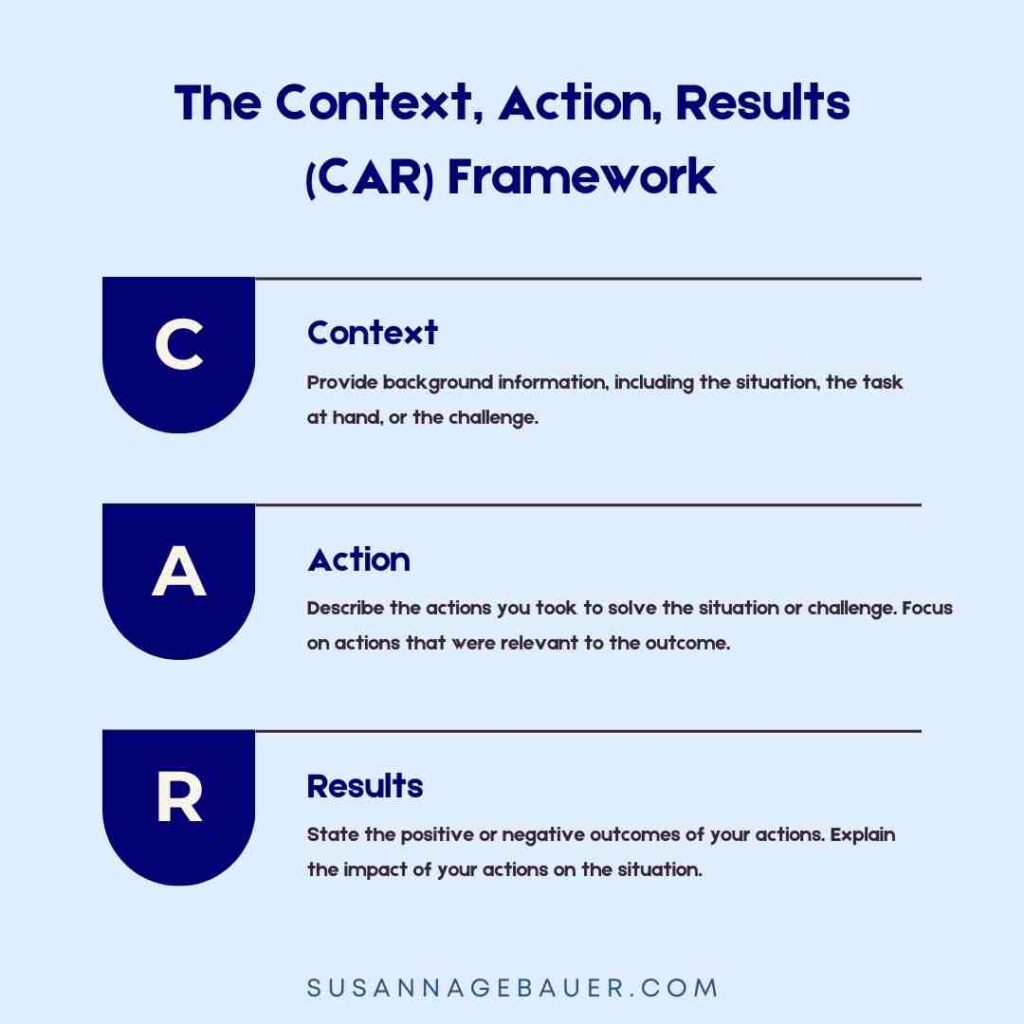
The Context, Action, Results (CAR) framework is a structured approach to sharing personal experiences clearly and concisely. It helps to focus on the key elements of a story, making it more engaging and memorable for the audience.
The CAR framework consists of three main components:
Context: Provide some background information, including the situation, the task at hand, or the challenge you faced. Describe the context in which your actions took place.
Action: Describe the specific actions you took to address the situation or challenge. Be specific and provide examples of your actions. Focus on the actions that were relevant to the outcome and the learning experience.
Results: State the positive or negative outcomes of your actions. Quantify the results whenever possible by using numbers, percentages, or other measurable metrics. Explain the impact of your actions on the situation or the overall goal.
By following the CAR framework, you can effectively communicate your experiences, skills, and accomplishments in a way that is clear, concise, and memorable for the audience.
#8 The Thesis, Antithesis, Synthesis framework
The Thesis, Antithesis, Synthesis framework is a method of critical thinking. It involves presenting opposing viewpoints and then synthesizing them to reach a higher level of understanding. It is a common approach in philosophy, argumentation, and persuasive writing.
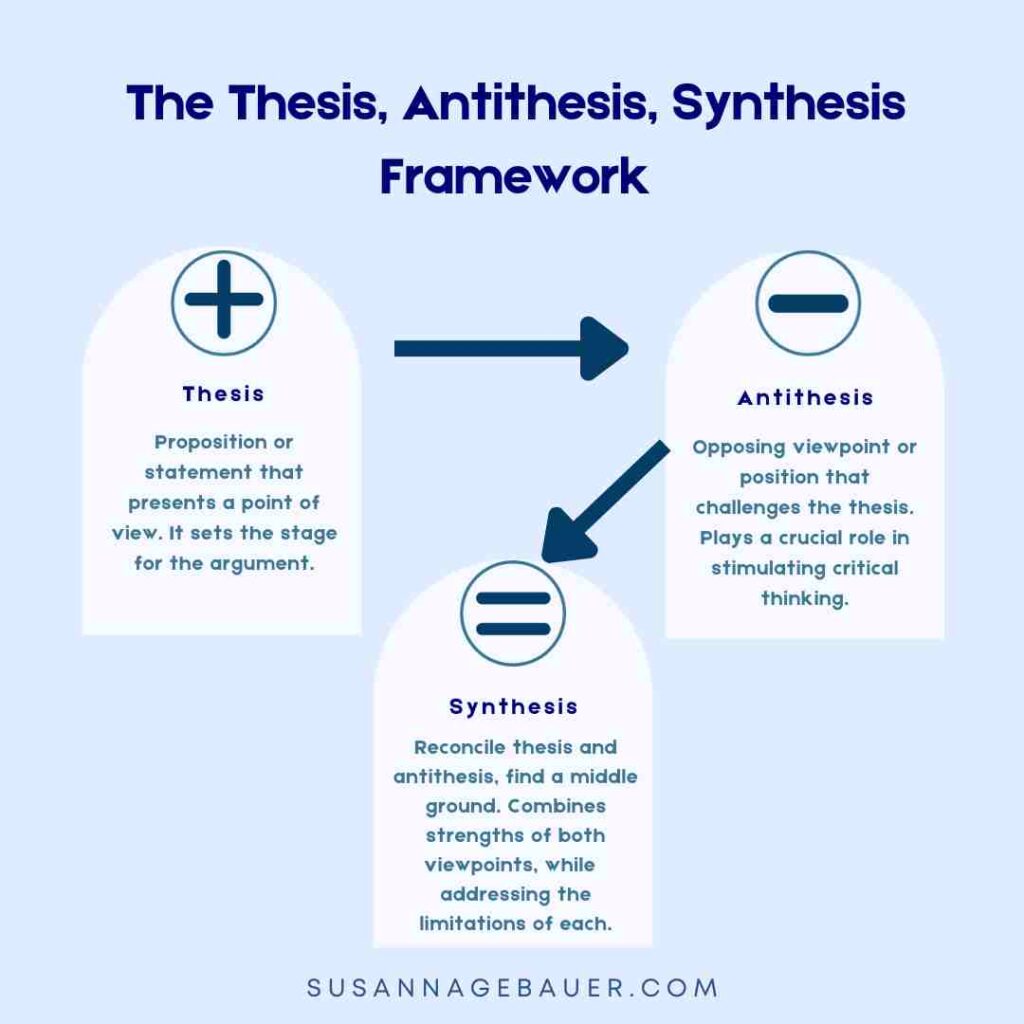
Thesis:
The thesis is a proposition or statement that presents a particular point of view or position on an issue. It is the initial statement that sets the stage for the argument and provides the foundation for the subsequent discussion.
Antithesis:
The antithesis is the opposing viewpoint or position that challenges the thesis. It presents a different perspective on the issue, highlighting the weaknesses or limitations of the thesis. The antithesis plays a crucial role in stimulating critical thinking and exploring the complexities of the topic.
Synthesis:
The synthesis is the process of reconciling the thesis and antithesis, attempting to find a middle ground or a more nuanced understanding of the issue. It involves combining the strengths of both viewpoints while acknowledging and addressing the limitations of each. The synthesis represents a higher level of understanding that goes beyond the mere presentation of opposing arguments.
The Thesis, Antithesis, Synthesis framework is not just about presenting different perspectives; it is about using those perspectives to drive deeper understanding and learning. It encourages active engagement with ideas, challenging assumptions, and seeking more comprehensive insights. This process is essential for critical thinking, effective communication, and personal growth.
#9 The Situation, Complication, Question, Answer (SCQA) framework
The Situation, Complication, Question, Answer (SCQA) framework is a versatile tool that can be used for a variety of purposes, including:
- Problem-solving: By clearly defining the problem, identifying the root cause of the complication, and formulating a question that addresses the issue, the SCQA framework can help you effectively identify and address problems.
- Decision-making: By outlining the situation, considering potential complications, framing questions that weigh the pros and cons of each option, and evaluating the answers, the SCQA framework can guide you toward well-informed decisions.
- Communication: By structuring your communication around the SCQA framework, you can effectively convey information, address concerns, and promote understanding.
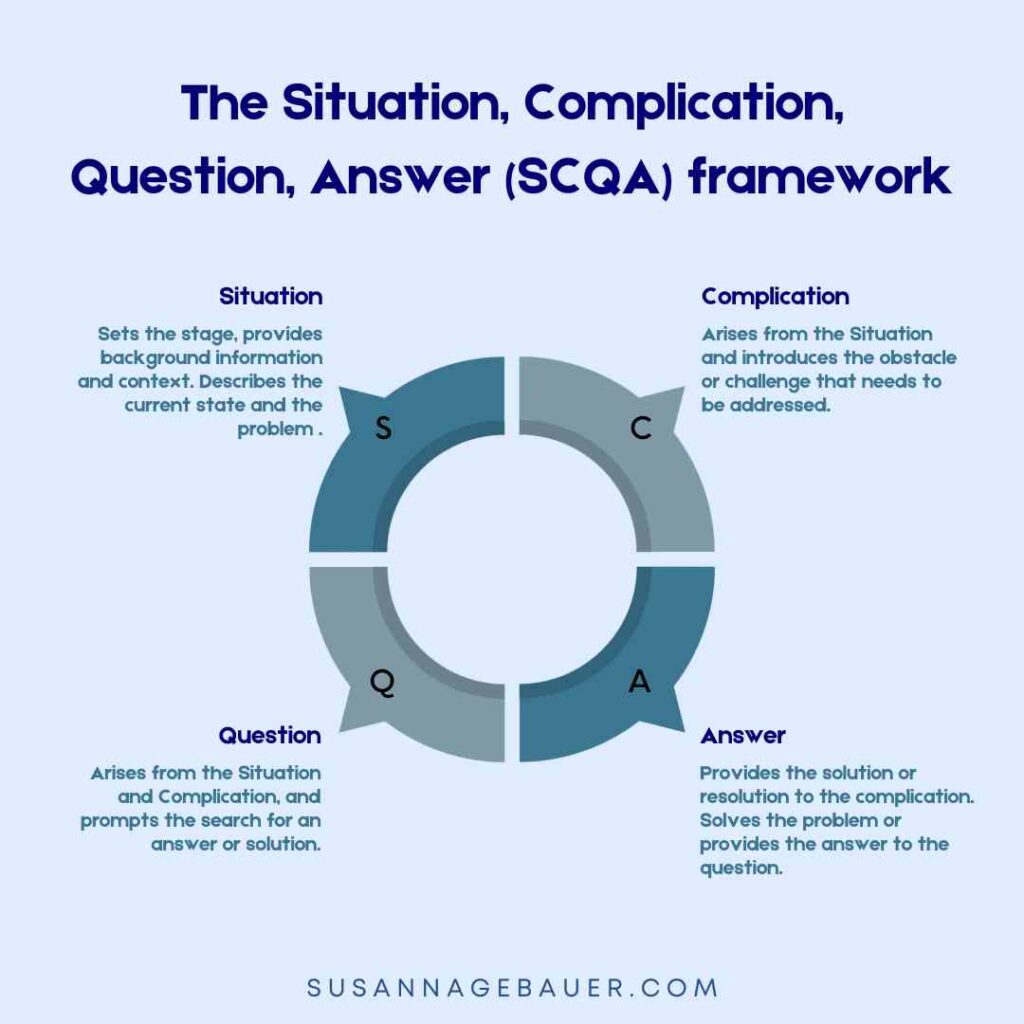
Situation:
The Situation sets the stage for the discussion by providing background information and context. It describes the current state and the problem or challenge at hand.
Complication:
The complication arises from the situation and introduces the obstacle or challenge that needs to be addressed. It describes the specific issue, the problem that needs to be solved, or the question that needs to be answered.
Question:
The question is the crux of the SCQA framework. It arises from the Situation and Complication, and it prompts the search for an answer or solution.
Answer:
The answer provides the solution or resolution to the complication. It solves the problem or provides the answer to the question. The answer should be well-supported, relevant, and actionable.
The SCQA framework can be applied in various contexts, from personal problem-solving to professional decision-making to effective communication. By following the SCQA steps, you can ensure that your discussions are clear, focused, and lead to meaningful outcomes.
Consider Business Storytelling Frameworks for your content!
Business storytelling frameworks provide you with a framework of suspense that speaks to the audience on an emotional level. The stories usually start by establishing a setting where the protagonist in the story is at a point in their journey where potential customers are right now. The stories continue to build a connection with the audience by relating the struggles, conflicts and challenges that the audience also experiences. The climax of the story is the discovery of a solution. This can then lead to an offer or trust building via numbers and results.
For successful business storytelling, ensure the context of your story is relevant to the question or the point you want to convey.
Avoid vague or generic descriptions. These fail to trigger emotions within your audience. Your personal story and experience speak to your audience on an emotional level when the story relates to feelings and situations your audience is familiar with and is looking for a way out.
Business storytelling frameworks help to structure your thoughts, organize information, and communicate effectively. They are a useful tool when you want to utilize emotional content.
But never forget that the effectiveness of any narrative depends on the storyteller’s ability to craft a resonant, authentic, and rich storyline. Don’t get lost in the frameworks if they stop the flow of your narrative. They are frameworks, you are the storyteller.
Learn all the other parts of content creation in this guide!

